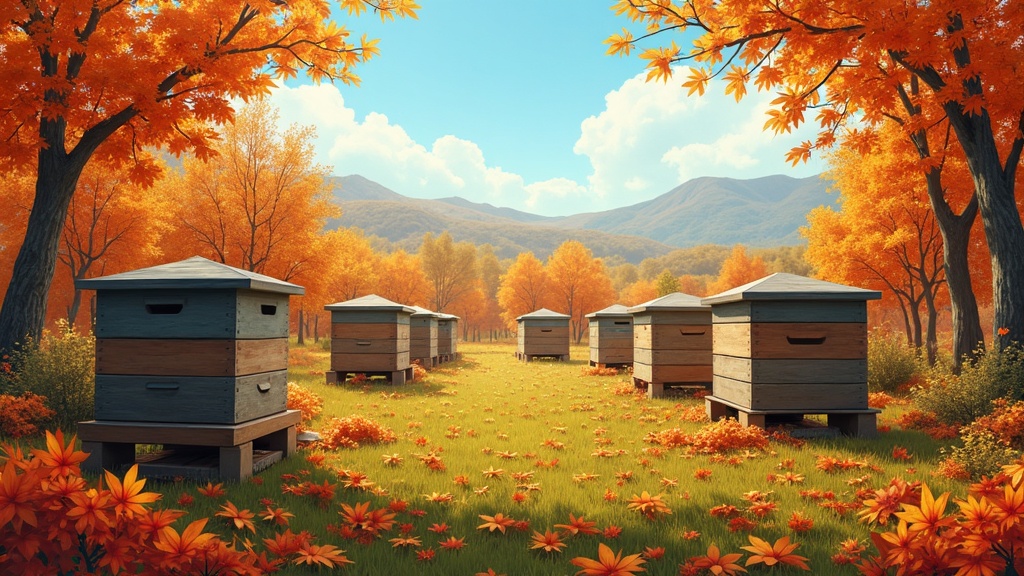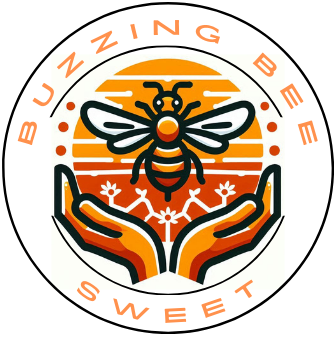Autumn is one of my favorite times to check on the hives. The crisp air, changing leaves, and last bursts of wildflowers always signal it’s time to help my bees prepare for colder months ahead. Proper autumn hive maintenance keeps colonies strong, healthy, and much more likely to make it through winter with plenty of bees to start spring buzzing. If you’re just getting started with beekeeping or want a refresher, this guide covers everything I’ve learned about fall hive care over the seasons.

Why Autumn Hive Maintenance Really Matters
Colony survival over winter heavily depends on what beekeepers do in autumn. Bees need enough population, food stores, and low pest pressure to stay healthy in chilly weather, when flying outside is nearly impossible. After summer, hives can be tired, robbed, or low on honey. That’s why taking action now is super important; it lets you spot issues early and fix them well before freezing nights arrive.
Even for new beekeepers, autumn is a solid time to check hive health without the heat and bee aggression of peak honey flows. If you skip fall maintenance, you could end up losing colonies to starvation or diseases like varroa mite infestations. Careful autumn prep sets your hive, and your stress levels, up for a much smoother spring start.
First Steps: Inspecting Your Hive in Fall
Usually, I do a main autumn inspection once night temps dip under 55°F (about 13°C), but before real frosts hit. Here are some basic steps to keep in mind during your check:
- Check Colony Strength: Look for at least enough bees to cover 5–6 frames. Fewer bees might not generate enough heat over winter.
- Assess Brood Pattern: Spotty or patchy brood can mean queen troubles or disease. Healthy brood is tight and consistent.
- Count Honey Stores: Most hives need 60 to 90 lbs of honey going into winter, depending on your climate. A full super plus some brood frames is my usual goal.
- Spot Disease or Pests: Scan for visible mites, deformed wings (DWV virus), or chalkbrood. I always scrape the bottom board and check for mite drop just to be sure.
Jotting down your notes as you go is pretty handy for tracking progress and decisions later. Photos help too, especially if you need to ask local beekeepers for a second opinion on what you’re seeing.
Feeding Bees in Autumn
Not every fall brings reliable nectar flows, especially as most flowers dry up and nights turn cool. If you open the hive and honey stores seem low, feeding might save your colony from winter starvation. Here’s my personal take on autumn feeding methods:
- 2:1 Sugar Syrup: Strong syrup mixes (two parts sugar to one part water) act like late-season honey and encourage bees to pack away stores. I tend to stop feeding syrup once nights get close to freezing, as cold syrup can increase hive moisture.
- Pollen Patties: If brood production looks light, I’ll sometimes tuck a pollen patty just inside the hive. It can help give a boost to bee health ahead of colder months, particularly in regions with long winters. I only use these if I see obvious shortages.
Frame feeders and topfeeders both work well, just make sure you don’t spill syrup around the hive. Spills attract wasps and robbers fast this time of year.
Managing Hive Pests and Diseases in Fall
Cooler weather pushes bees to cluster tightly, which is great for warmth but can hide mites and diseases. The earlier you check and treat, the better. Here’s what I always check for:
- Varroa Mites: The most persistent fall pest. I check sticky boards or do a mite wash if I’m unsure. If the mite count is high, I’ll use a treatment like oxalic acid vapor or thymol (following label directions and checking what’s legal in my area).
- Small Hive Beetles: They become less of a problem after frost sets in, but if you spot beetles or larvae, clean out slimy comb and reduce unused space in the hive. Traps can also help.
- Nosema: It’s tough to see without a microscope, but look for dysentery streaks or weak, sluggish bees. Keeping the hive dry is a big prevention step.
If you’re unsure about treatments or see something odd, I’d suggest connecting with a local beekeeping club or your extension office—they usually know what issues are common in your area.
Winterizing the Hive: Practical Autumn Prep
Once honey stores, pests, and the queen look good, it’s time to button up the hive. Autumn prep keeps the colony dry, warm, and safe from winter’s worst. Here’s a breakdown of what I always do:
- Reduce Hive Entrance: I swap in an entrance reducer or mouse guard to keep critters out, while still letting bees come and go. Mice love hives when it’s cold, so don’t skip this step.
- Add Insulation: Some beekeepers wrap their hives or use insulated covers, especially up north. I’ll sometimes add a moisture quilt or a slab of foam board on top. Moisture is more dangerous than cold for overwintering bees.
- Check Ventilation: Good airflow prevents condensation, which can drip down and chill bees. A small upper entrance or notched inner cover helps moist air escape.
- Remove Empty Boxes: If boxes are empty, take them away. Too much space makes heat harder for bees to maintain.
A bit of hay or dry leaves around the hive base helps with wind and snow, but make sure entrances don’t get blocked up. Doublecheck everything before a real cold snap comes along.
Common Autumn Beekeeping Challenges
- Robbing: With nectar scarce, nearby bees and wasps will look for weak hives to steal honey. Keeping entrances small and avoiding spilled syrup helps stop robbing before it starts.
- Queen Issues: If your queen’s running out of steam, you’ll see very little brood or a spotty pattern. Late requeening can work if warm weather holds, but if not, combine weak colonies to boost numbers.
- Weather Swings: Warm early autumn can fool bees into thinking there’s still time to forage. Cold shocks that follow drain resources fast, so focus on getting hives winterready no matter how nice those September days feel.
Feeding and Fending Off Robbers
When I feed hives in autumn, I always watch for signs of robbing: sudden fighting, bees trying to sneak in through cracks, or piles of wax outside the entrance. I’ve found it’s safest to feed most hives late in the evening and close to the cluster, with entrance reducers already in place. Moving syrup inside the hive, with a frame feeder, also cuts risk.
Tools and Supplies I Recommend for Autumn Maintenance
- Hive Tool: Helps pry apart sticky frames during cool inspections.
- Bee Brush: Gently moves lingering bees off frames when you check food stores.
- Entrance Reducer or Mouse Guard: Keeps out pests but lets bees move freely.
- Frame Feeder or Top Feeder: Makes autumn feeding less messy and reduces robber risk.
- Insulation Boards or Moisture Quilt: Adds warmth and helps control humidity above the cluster.
You don’t need fancy gear; just reliable basics that make the job easier and keep your bees comfortable.
Frequently Asked Questions
How can I tell if my hive has enough honey for winter?
Check both weight and frame coverage. A full deep super weighs about 50 to 60 lbs. If most outer frames are heavy and packed with honey, you’re set. If not, start feeding right away.
Should I requeen in autumn?
If the queen is failing and it’s early in autumn with mild weather, you can try. Later in the season, it’s usually better to combine weak hives with a strong one for a better shot at survival.
What’s the best way to insulate against moisture?
A moisture quilt (a box with wood shavings or absorbent material) above the inner cover is an easy fix for excess humidity. Also, keep entrances clear for airflow.
Can I leave supers on the hive if they’re empty?
I remove unused boxes so the bees don’t waste energy heating empty space. Stack boxes with honey right above the cluster, where they can access food easily.
Seasonal Beekeeping: Practical Wisdom from My Own Experience
I always start autumn prep by clearing my beeyard of weeds and leaves so predators like skunks or mice can’t get comfy. Painting or wrapping hives in light colors helps them stand out against the snow if you live somewhere with harsh winters. Talking with local beekeepers about frost dates and feeding routines also gives you a head start—sometimes what works in one state isn’t quite right in another!
Autumn hive maintenance is less about perfection and more about paying attention, making small adjustments as needed, and giving bees the best shot at a healthy spring revival. With some careful checks, a bit of syrup, and a watchful eye for pests, you and your bees should be set for peaceful winter months ahead. You can look forward to a loud, buzzing return as soon as the weather breaks.
If you want to learn even more, check out local beekeeping workshops, where you can trade autumn prep tips with other keepers and spot region-specific advice. Practical guidance from fellow beekeepers often leads to the best tricks and discoveries, so don’t be afraid to ask around when you have questions about fall maintenance or prepping your hive for the colder months. You and your bees will thank you come spring!

This is a great breakdown of maintaining bee hives in the autumn. I understand now that if fall beehive maintenance is neglected, this could create a bad situation for the bees, such as diseases or even starvation. I have two questions for you: 1) Is late “requeening” a difficult task if it turns cold too quickly? 2) I understand installing an upper entrance to the hive can provide increased ventilation. Can this allow other “pests” to enter, too? Thank you for a very informative post.
Best wishes,
Kent
Hi Kent!
Thank you, Kent, for your thoughtful comment! You’re right—autumn prep is crucial for setting colonies up for winter success. To your first question: late requeening can be tricky because cooler weather reduces the bees’ acceptance of a new queen, so it’s best done earlier in fall when they’re still active. As for upper entrances, they’re excellent for ventilation and moisture control, but yes, they can sometimes invite pests like wasps or mice—using a reducer or mesh can help manage that. Great questions, and I’m glad you found the guide helpful!
/Mats